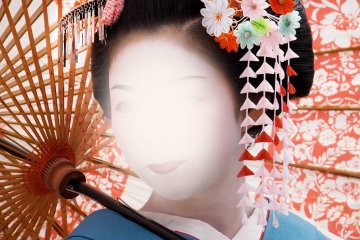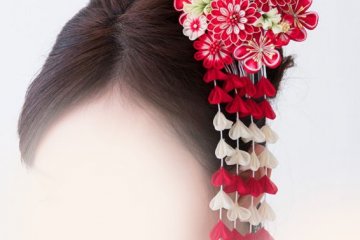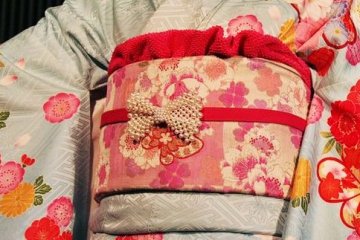Women all over the world have been wearing jewelry since ancient times. The most familiar and popular jewelry include beads, necklace, bracelets, earrings and headwear. In Japan, though, hair ornaments have been particularly popular.
During the Jomon period (13,000-300 BC), these hair ornaments were decorated with thin sticks as protection from evil spirits. These eventually developed into a kind of kushi comb.

In the Nara period (710-794), various types of hair ornaments were imported from China which, in the Heian period (794-1185), became known as kanzashi. Kanzashi gained particular popularity in the 1700s with kanzashi artisans commanding much respect with some being revered as the heritage of Japan. These masters understand the principles of kanzashi creation, the compatibility of the materials used for the traditional ornaments in each season.
The custom of decorating with fresh flowers as a protection against evil spirits appeared in Japan in ancient times. Since fresh flowers wither quickly, they began to be replaced with artificial ones made of the finest silk fixed with rice glue. Tsumami-kanzashi differs from other styles by a complex application made of pieces of fabric requiring incredible accuracy and painstaking care to put together. Tsumami-kanzashi is also called hana-kanzashi due to the strong use of flowers such as ume (plums), sakura (cherries), fuji (wisteria), and kiku (chrysanthemums).

Kanzashi is made of various materials including wood, gold, silver, gilded and silver-plated metals, tortoiseshell, jade and other semi-precious stones. Japanese silk also features.
Interestingly, in Japan, the wearing of ornaments was regulated - kanzashi had to correspond to the social status and age of the wearer. There are also differences among geisha; maiko wear ornate hana-kanzashi according to the season, and geiko - simple wooden combs and hairpins.

Like hair ornaments, obi belts, in addition to being practical, serve as a decoration. Obi-jime lace, which ties together an obi, is fixed with obi-dome jewelry or intricate knots. The various ways in which an obi can be tied is also part of an outfit's ornamentation.

Currently, traditional hairstyles and ornaments can be seen at wedding ceremonies, on Seijin-shiki (Coming of Age Day, second Monday of January), in traditional theater and at geisha performances. The haristyles of young girls, too, are often prepared for special ceremonies during the Shichi-Go-San holiday.

As a final touch, in addition to the above, traditional Japanese clothing will usually include a fan and an umbrella.














